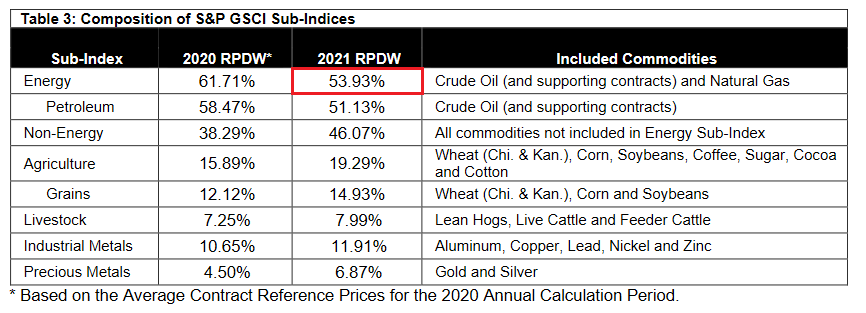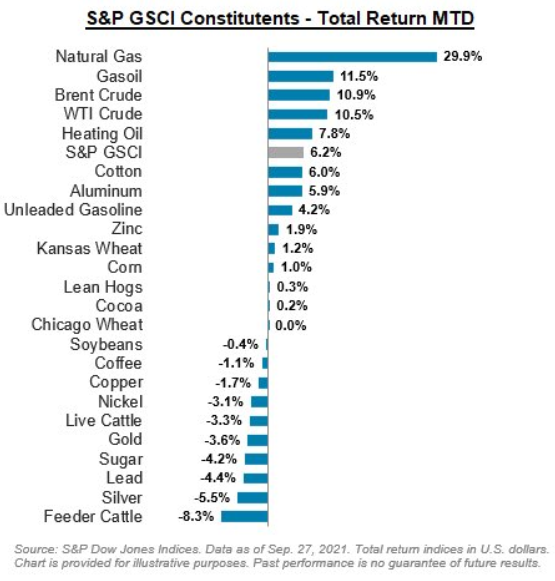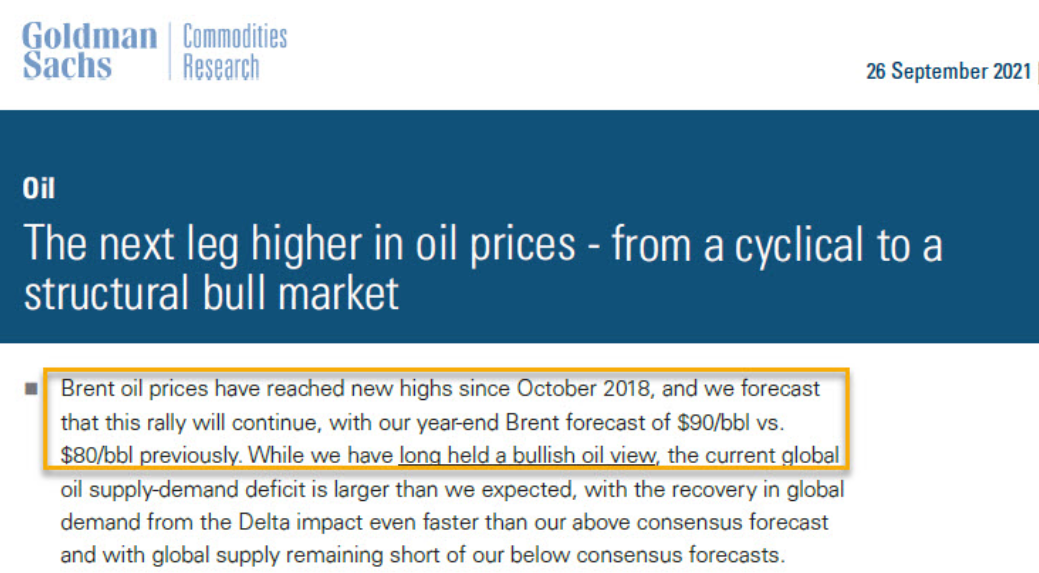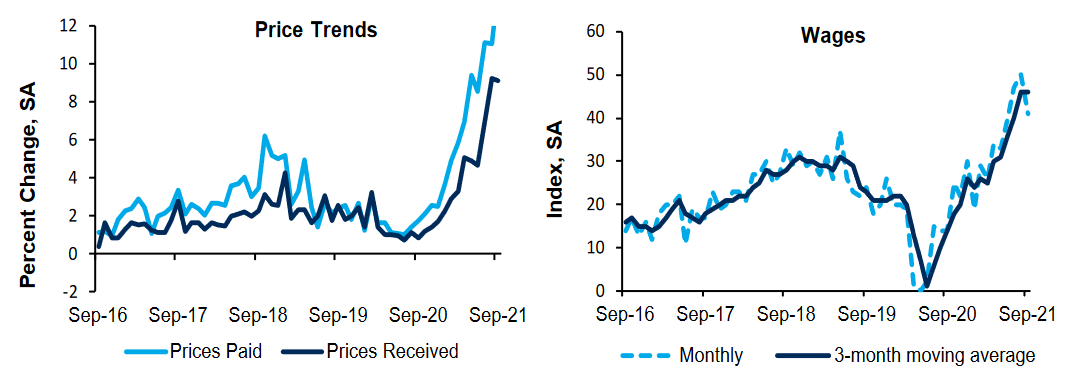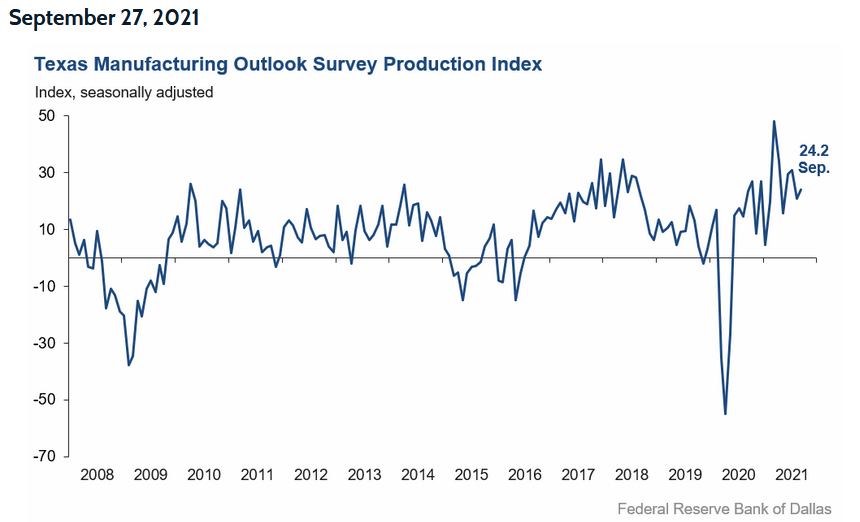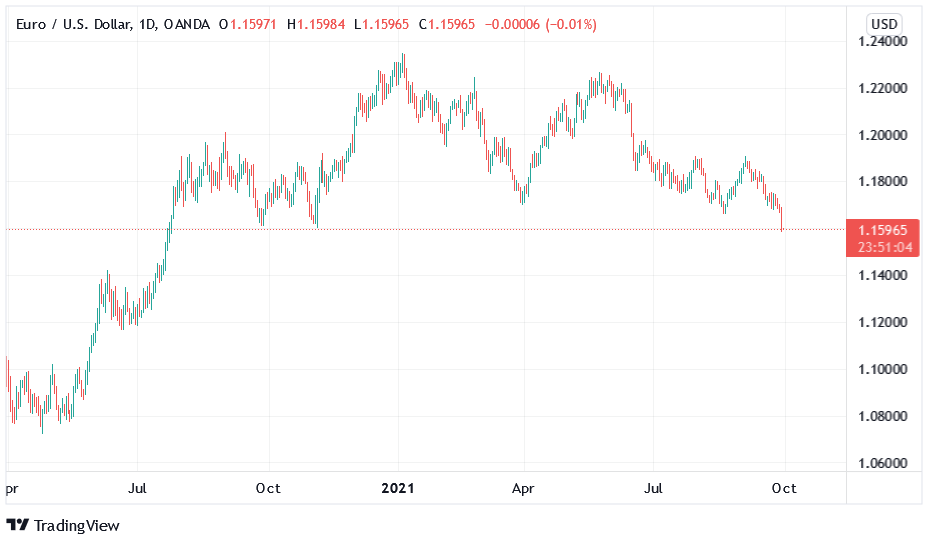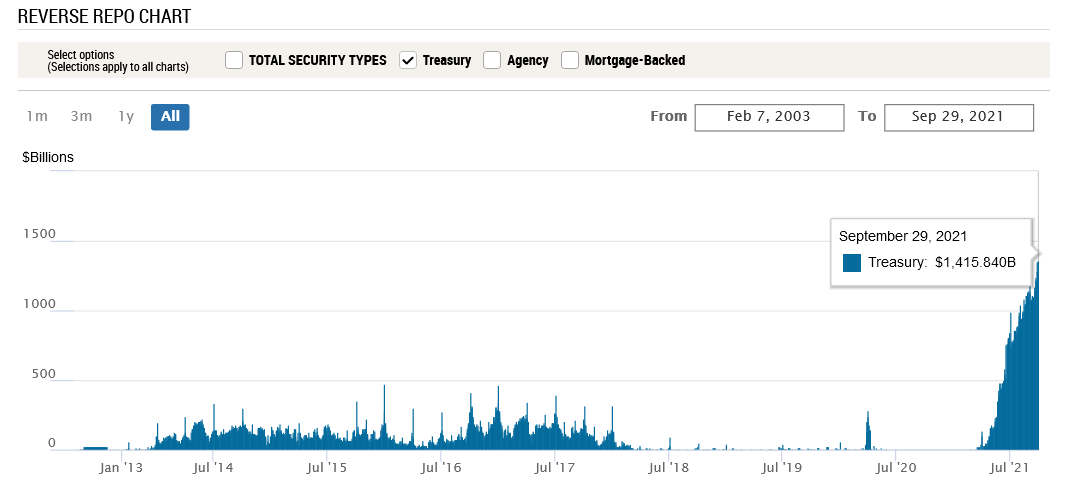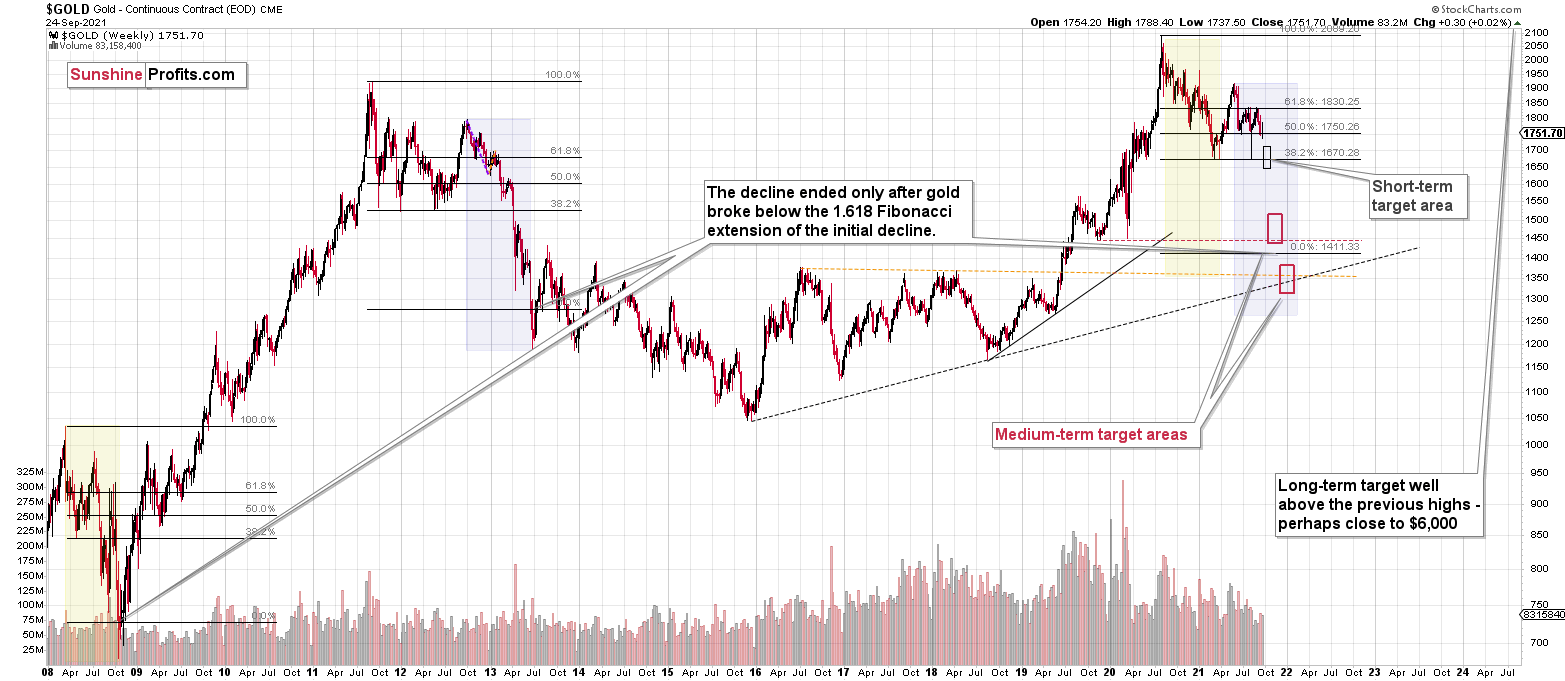Briefly: in our opinion, a full (300% of the regular position size) speculative short position in silver is justified from the risk/reward point of view at the moment of publishing this Alert. I’m moving the profit-take level for our already profitable positions lower.
You will find today’s technical analysis in the video format below; the profit-take details for the current trade can be found under the summary of today’s analysis in the “Trading capital” section.
And as far as the more fundamental approach is concerned, you will find the details below.
Capitulation
With Fed Chairman Jerome Powell finally having his ‘come-to-Jesus’ moment on Sep. 29, the central bank chief’s skittish words helped light a fire under the USD Index. For context, I’ve been warning for months that Powell remains materially behind the inflation curve. And with his indecisive speech upending the Fed’s confidence game, the gambit is showing signs of unraveling.
Speaking at an ECB panel discussion on Sep. 29, he said:
“The current inflation spike is really a consequence of supply constraints meeting very strong demand. And that is all associated with the reopening of the economy, which is a process that will have a beginning, middle and an end. It’s very difficult to say how big the effects will be in the meantime or how long they last.”
For context, first it was “base effects,” then it was “transitory” and now “it’s very difficult to say.”
He continued:
“It’s also frustrating to see the bottlenecks and supply chain problems not getting better – in fact, at the margins apparently getting a little bit worse. We see that continuing into next year probably, and holding up inflation longer than we had thought.”
What’s more, Powell actually admitted that the Fed is facing a conundrum that it hasn’t dealt with “for a very long time.”
“Managing through that process over the next couple of years is… going to be very challenging because we have this hypothesis that inflation is going to be transitory. We think that’s right. But we are concerned about underlying inflation expectations remaining stable, as they have so far.”
Wow. If that’s not capitulation, I don’t know what is.
For context, I wrote on Sep. 24:
I’ve warned on several occasions that the only way for the Fed to control inflation is to increase the value of the U.S. dollar and decrease the value of commodities. However, with commodities’ fervor accelerating on Sep. 23 – a day when the USD Index declined – the price action should concern Chairman Jerome Powell. As a result, FOMC participants’ 2022 inflation forecast is likely wishful thinking and they may find that a faster liquidity drain (which is bullish for the U.S. dollar) is their only option to control the pricing pressures.
Speaking of which, the S&P Goldman Sachs Commodity Index (S&P GSCI) has rallied by ~5% for the month of September. For context, the S&P GSCI contains 24 commodities from all sectors: six energy products, five industrial metals, eight agricultural products, three livestock products and two precious metals. However, energy accounts for roughly 54% of the index’s movement.
Please see below:
As well, if you analyze the graphic below, you can see the impact that rising energy prices had on the S&P GSCI’s performance in September (MTD returns as of Sep. 27).
To that point, with Brent and WTI surging recently and the latter on track for six straight weeks of weekly gains, Goldman Sachs has upped its year-end Brent target to $90 a barrel. Calling it the “revenge” of the old economy, Jeff Currie, Goldman Sachs global head of commodities research, said that “poor returns saw capital redirected away from the old economy to the new economy. It’s not unique to Europe, it’s not unique to energy, it’s a broad-based old-economy problem.”
Thus, in his view, commodity prices need to be “much higher to get returns sufficient to start attracting capital. People wanted a quick return, and now you’re paying the price for it.”
Please see below:
Supporting the thesis, Bank of America commodities strategist Francisco Blanch told Bloomberg on Sep. 28 that Brent could hit $100 a barrel in 2022 and that a “cold winter” could actually pull forward the forecast.
He said:
“First, there is plenty of pent up mobility demand after an 18 month lockdown. Second, mass transit will lag, boosting private car usage for a prolonged period of time. Third, pre-pandemic studies show more remote work could result in more miles driven, as work-from-home turns into work-from-car. On the supply side, we expect government policy pressure in the U.S. and around the world to curb cap-ex over coming quarters to meet Paris goals. Secondly, investors have become more vocal against energy sector spending for both financial and ESG reasons. Third, judicial pressures are rising to limit carbon dioxide emissions. In short, demand is poised to bounce back and supply may not fully keep up, placing OPEC in control of the oil market in 2022.”
Now, the important point isn’t whether or not Currie and Blanch are correct. The important point is that higher oil prices are mutually exclusive to Powell’s 2% inflation goal. For example, the Commodity Producer Price Index (PPI) – which is a reliable indicator of the next month’s Consumer Price Index (CPI) – recorded its highest monthly year-over-year (YoY) percentage increase in August since 1974. What’s more, the sky-high reading occurred with the S&P GSCI declining by ~2% in August (that’s why monitoring surging container rates is so important). However, as mentioned, the S&P GSCI has already risen by ~5% in September and container rates have also made new highs. As a result, Powell’s hawkish shift isn’t nearly hawkish enough to solve his inflationary dilemma.
Inflation Isn’t Going Anywhere
As further evidence, the Richmond Fed released its Fifth District Survey of Manufacturing Activity on Sep. 28. And while the headline index turned negative as output slumped, pricing pressures remained materially elevated.
Please see below:
Likewise, the Dallas Fed released its Texas Manufacturing Outlook Survey on Sep. 27. The report revealed:
“Prices and wages continued to increase strongly in September. The price indexes climbed further, with the raw materials prices index at 80.4 and the finished goods prices index at 44.0, an all-time high. The wages and benefits index held steady at a highly elevated reading of 42.7.”
For a visual of the overall index, please see below:
Furthermore, the Dallas Fed also released its Texas Service Sector Outlook Survey and its Texas Retail Outlook Survey on Sep. 28. And though the U.S. service sector has suffered the brunt of the Delta variant’s wrath, pricing pressures remained. The report revealed:
“Wage pressures eased in September, though remained at historically high levels, while price pressures remained highly elevated. The wages and benefits index declined from 32.6 to 26.9. The selling prices index was largely unchanged at 20.2, with nearly a quarter of firms reporting increased prices compared with August, while the input prices index inched up one point to 42.9.”
More importantly, though, the Texas Retail Outlook Survey revealed:
“Retail price pressures surged once again in September after some signs of moderation in August, while wage pressures held steady. The selling prices index surged nearly 11 points to 50.4 – with 58 percent of retailers increasing prices compared with August – while the input prices index increased from 41.3 to 50.1. The wages and benefits index was flat at 24.6.”
For a visual of the overall index, please see below:
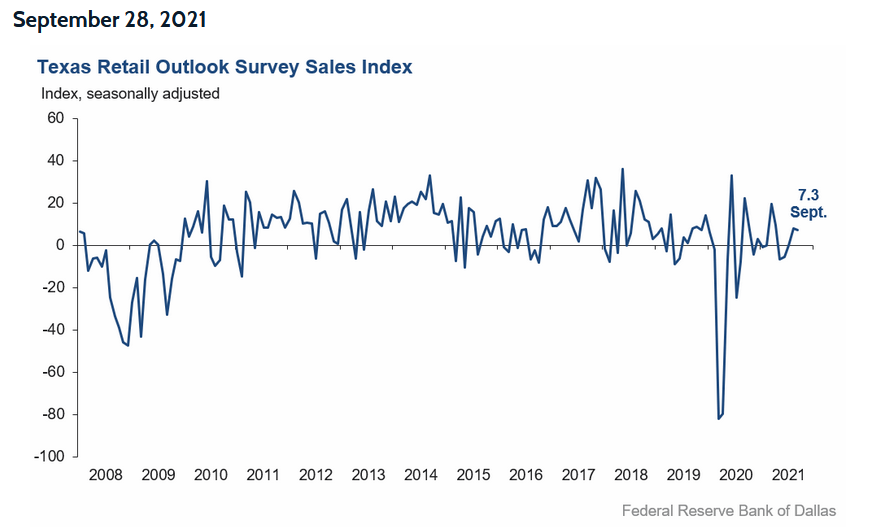 And as the drama unfolds and Powell’s inflationary conundrum intensifies, his hawkish rhetoric on Sep. 29 helped sink the EUR/USD. For context, the EUR/USD accounts for nearly 58% of the movement of the USD Index. And with the currency pair collapsing below 1.1600 on Sep. 29 and closing below key 2020 support, the European dam could be about to break.
And as the drama unfolds and Powell’s inflationary conundrum intensifies, his hawkish rhetoric on Sep. 29 helped sink the EUR/USD. For context, the EUR/USD accounts for nearly 58% of the movement of the USD Index. And with the currency pair collapsing below 1.1600 on Sep. 29 and closing below key 2020 support, the European dam could be about to break.
Please see below:
Reverse Repos Hit Another All-Time High!
Also bullish for the U.S. dollar, with Powell’s liquidity circus still on full display, there is too much money floating around with too little use. And upping the ante on what I’ve been highlighting for months, after 80 counterparties drained nearly $1.416 trillion out of the U.S. financial system on Sep. 29, the Fed’s daily reverse repurchase agreements hit another all-time high.
Please see below:
To explain, a reverse repurchase agreement (repo) occurs when an institution offloads cash to the Fed in exchange for a Treasury security (on an overnight or short-term basis). And with U.S. financial institutions currently flooded with excess liquidity, they’re shipping cash to the Fed at an alarming rate. I’ve been warning for months that the activity is the fundamental equivalent of a taper due to the lower supply of U.S. dollars (which is bullish for the USD Index). Thus, while we await a formal announcement from the Fed, the U.S. dollar’s fundamental foundation remains robust.
The bottom line? Powell’s only hope to curb inflation is to strengthen the U.S. dollar and weaken commodity (including gold and silver) prices. For context, major futures contracts are priced in U.S. dollars. And when the dollar rallies, it’s more expensive for foreign buyers (in their currency) to purchase the underlying commodities. As a result, a stronger U.S. dollar often stifles demand. And with the current supply/demand dynamics favoring higher commodity prices, Powell will have to work his magic — strengthen the dollar and reduce demand — if he wants his inflation problem to subside.
In conclusion, gold, silver (ouch) and mining stocks sunk like stones on Sep. 29. And with the USD Index cutting through 94 like a knife through butter, new 2021 lows in the EUR/USD were accompanied by new 2021 highs in the USD Index. Moreover, with the momentum poised to continue, the PMs’ medium-term outlooks remain quite somber. As a result, further weakness will likely materialize before brighter days emerge (probably) near the end of the year.
Overview of the Upcoming Part of the Decline
- It seems to me that the corrective upswing in gold is over, and the big decline seems to be already underway. We are very likely in the final part of this short-term decline, which is why I expect silver to catch up with mining stocks and decline quite substantially.
- It seems that the first stop for gold will be close to its previous 2021 lows, slightly below $1,700. Then it will likely correct a bit, but it’s unclear if I want to exit or reverse the current short position based on that – it depends on the number and the nature of the bullish indications that we get at that time. Before the next big slide, I will likely prefer to get back to the short position in the junior mining stocks.
- After the above-mentioned correction, we’re likely to see a powerful slide, perhaps close to the 2020 low ($1,450 - $1,500).
- If we see a situation where miners slide in a meaningful and volatile way while silver doesn’t (it just declines moderately), I plan to – once again – switch from short positions in miners to short positions in silver. At this time, it’s too early to say at what price levels this could take place, and if we get this kind of opportunity at all – perhaps with gold close to $1,600.
- I plan to exit all remaining short positions when gold shows substantial strength relative to the USD Index while the latter is still rallying. This might take place with gold close to $1,350 - $1,400. I expect silver to fall the hardest in the final part of the move. This moment (when gold performs very strongly against the rallying USD and miners are strong relative to gold after its substantial decline) is likely to be the best entry point for long-term investments, in my view. This might also happen with gold close to $1,375, but it’s too early to say with certainty at this time. I expect the final bottom to take place near the end of the year, perhaps in mid-December.
- As a confirmation for the above, I will use the (upcoming or perhaps we have already seen it?) top in the general stock market as the starting point for the three-month countdown. The reason is that after the 1929 top, gold miners declined for about three months after the general stock market started to slide. We also saw some confirmations of this theory based on the analogy to 2008. All in all, the precious metals sector is likely to bottom about three months after the general stock market tops.
- The above is based on the information available today, and it might change in the following days/weeks.
You will find my general overview of the outlook for gold on the chart below:
Please note that the above timing details are relatively broad and “for general overview only” – so that you know more or less what I think and how volatile I think the moves are likely to be – on an approximate basis. These time targets are not binding or clear enough for me to think that they should be used for purchasing options, warrants or similar instruments.
Summary
To summarize, the outlook for the precious metals sector remains extremely bearish for the next few months. It seems that we are in the final part of this short-term decline, which is why I expect silver to catch-up with mining stocks and decline quite substantially.
Congratulations on reaping great profits from the previous short position in the junior mining stocks! While juniors are likely to decline more, it seems to me that the profits that one could get from shorting silver right now are likely to be even bigger.
From the medium-term point of view, the key two long-term factors remain the analogy to 2013 in gold and the broad head and shoulders pattern in the HUI Index. They both suggest much lower prices ahead.
It seems that our profits from the short positions are going to become truly epic in the following months.
After the sell-off (that takes gold to about $1,350 - $1,500), I expect the precious metals to rally significantly. The final part of the decline might take as little as 1-5 weeks, so it's important to stay alert to any changes.
Most importantly, please stay healthy and safe. We made a lot of money last March and this March, and it seems that we’re about to make much more on the upcoming decline, but you have to be healthy to enjoy the results.
As always, we'll keep you - our subscribers - informed.
By the way, we’re currently providing you with the possibility to extend your subscription by a year, two years or even three years with a special 20% discount. This discount can be applied right away, without the need to wait for your next renewal – if you choose to secure your premium access and complete the payment upfront. The boring time in the PMs is definitely over, and the time to pay close attention to the market is here. Naturally, it’s your capital, and the choice is up to you, but it seems that it might be a good idea to secure more premium access now while saving 20% at the same time. Our support team will be happy to assist you in the above-described upgrade at preferential terms – if you’d like to proceed, please contact us.
To summarize:
Trading capital (supplementary part of the portfolio; our opinion): Full speculative short position (300% of the full position) in silver is justified from the risk to reward point of view with the following binding exit profit-take price levels:
Silver futures profit-take exit price: $19.12
SLV profit-take exit price: $17.72
ZSL profit-take exit price: $41.38
HZD.TO profit-take exit price: $31.98
OR if gold reaches $1,683 – in this case, I think that taking profits and closing the short position in silver (and related instruments) will be justified from the risk to reward point of view, regardless of silver’s price.
I don’t have a stop-loss level for this trade.
For-your-information targets (our opinion; we continue to think that mining stocks are the preferred way of taking advantage of the upcoming price move, but if for whatever reason one wants / has to use silver or gold for this trade, we are providing the details anyway.):
Gold futures downside profit-take exit price: $1,683
GDXJ: $35.73
All mining-stock-related instruments: if gold reaches $1,683 or the GDXJ reaches $35.73 (whichever is reached first), I would exit all remaining short positions in any mining stock trading vehicles aimed at profiting from the declines in the mining stocks.
Long-term capital (core part of the portfolio; our opinion): No positions (in other words: cash
Insurance capital (core part of the portfolio; our opinion): Full position
Whether you already subscribed or not, we encourage you to find out how to make the most of our alerts and read our replies to the most common alert-and-gold-trading-related-questions.
Please note that we describe the situation for the day that the alert is posted in the trading section. In other words, if we are writing about a speculative position, it means that it is up-to-date on the day it was posted. We are also featuring the initial target prices to decide whether keeping a position on a given day is in tune with your approach (some moves are too small for medium-term traders, and some might appear too big for day-traders).
Additionally, you might want to read why our stop-loss orders are usually relatively far from the current price.
Please note that a full position doesn't mean using all of the capital for a given trade. You will find details on our thoughts on gold portfolio structuring in the Key Insights section on our website.
As a reminder - "initial target price" means exactly that - an "initial" one. It's not a price level at which we suggest closing positions. If this becomes the case (like it did in the previous trade), we will refer to these levels as levels of exit orders (exactly as we've done previously). Stop-loss levels, however, are naturally not "initial", but something that, in our opinion, might be entered as an order.
Since it is impossible to synchronize target prices and stop-loss levels for all the ETFs and ETNs with the main markets that we provide these levels for (gold, silver and mining stocks - the GDX ETF), the stop-loss levels and target prices for other ETNs and ETF (among other: UGL, GLL, AGQ, ZSL, NUGT, DUST, JNUG, JDST) are provided as supplementary, and not as "final". This means that if a stop-loss or a target level is reached for any of the "additional instruments" (GLL for instance), but not for the "main instrument" (gold in this case), we will view positions in both gold and GLL as still open and the stop-loss for GLL would have to be moved lower. On the other hand, if gold moves to a stop-loss level but GLL doesn't, then we will view both positions (in gold and GLL) as closed. In other words, since it's not possible to be 100% certain that each related instrument moves to a given level when the underlying instrument does, we can't provide levels that would be binding. The levels that we do provide are our best estimate of the levels that will correspond to the levels in the underlying assets, but it will be the underlying assets that one will need to focus on regarding the signs pointing to closing a given position or keeping it open. We might adjust the levels in the "additional instruments" without adjusting the levels in the "main instruments", which will simply mean that we have improved our estimation of these levels, not that we changed our outlook on the markets. We are already working on a tool that would update these levels daily for the most popular ETFs, ETNs and individual mining stocks.
Our preferred ways to invest in and to trade gold along with the reasoning can be found in the how to buy gold section. Furthermore, our preferred ETFs and ETNs can be found in our Gold & Silver ETF Ranking.
As a reminder, Gold & Silver Trading Alerts are posted before or on each trading day (we usually post them before the opening bell, but we don't promise doing that each day). If there's anything urgent, we will send you an additional small alert before posting the main one.
Thank you.
Przemyslaw Radomski, CFA
Founder, Editor-in-chief


